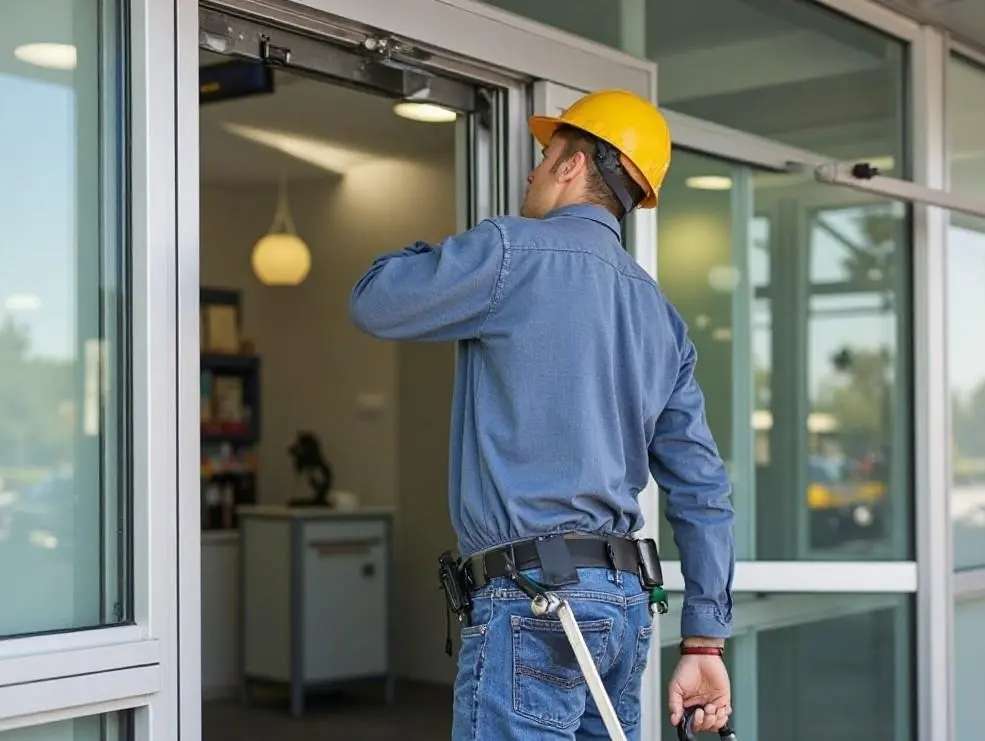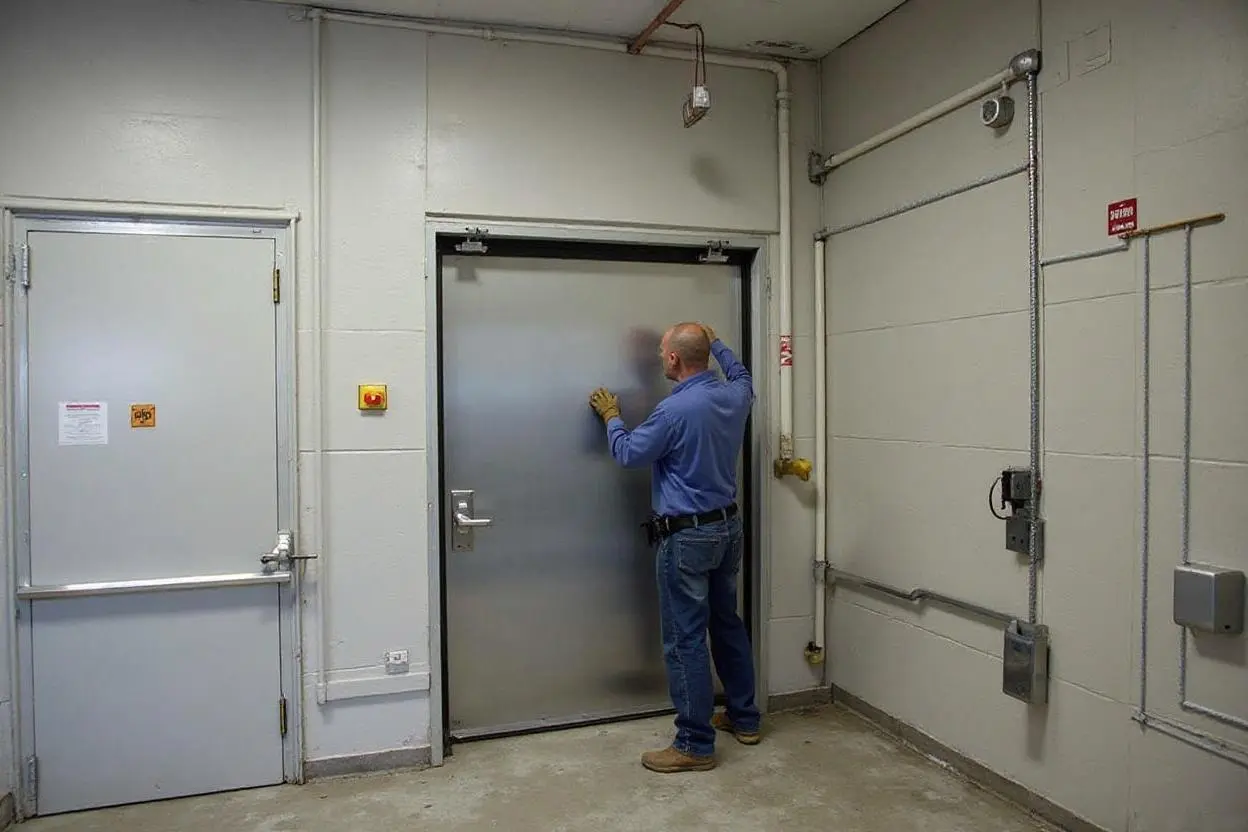
High-Traffic Automatic Door Maintenance Buffalo: Best Practices for Stores and Hospitals
Reliable automatic doors keep people moving and businesses open. In Buffalo, NY, high-traffic entrances take a beating from lake-effect winters, salt, and temperature swings. A careful maintenance plan lowers downtime, reduces liability, and extends equipment life. For hospital facilities managers, store owners on Elmwood and Niagara Street, and property teams in Cheektowaga, Amherst, and West Seneca, a clear routine backed by responsive service pays for itself.
What high traffic does to an automatic door in Buffalo
Heavy footfall wears rollers, tracks, and pivots faster. Repeated impacts from carts, wheelchairs, and stretchers misalign guide rails and break safety beams. Snow and salt create corrosion and seize hinges. Moisture seeps into sensors and control boards, causing intermittent faults that are hard to replicate. Doors that open to Delaware Avenue wind tunnels or hospital ambulance loops see stronger pressure changes, which strain operators and belts. These patterns shape the maintenance priorities: keep moving parts clean and lubricated, protect electronics, and test safety features under real conditions.
Safety and compliance come first
Automatic sliding and swinging doors must detect and protect pedestrians, meet ANSI/BHMA A156 standards, and function reliably during power loss. In hospitals, clear width and hold-open times affect patient transport and fire compartmentalization. Stores have ADA expectations for approach speeds and forces. A maintenance visit that skips safety sensors or ignores door speeds invites risk. A documented inspection schedule is as important as the repair itself, especially for Joint Commission surveys and insurance reviews.
A practical maintenance rhythm for Buffalo facilities
For a grocery on Hertel Avenue, a monthly check catches salt buildup before it grinds rollers. For a medical center near the Buffalo Niagara Medical Campus, weekly walk-throughs by in-house staff plus quarterly professional service keeps entrances predictable through flu season. Age, usage, and door type guide frequency. As a rule of thumb, doors crossing 1,000 cycles per day merit monthly service in winter and bi-monthly in milder months. Older operators over 10 years may need shorter intervals.

The professional visit: what should be included
A skilled technician does more than wipe a track and leave. The visit should cover the full path of travel, from approach to close, with measured tests and adjustments. Expect thorough checks of sensors, operators, mechanicals, and controls, and expect findings in writing. If the door serves an ER or pharmacy entrance, the tech should time open/close cycles during peak use and adjust for stretcher clearance and crowd flow.
Winterization for Buffalo’s salt, slush, and cold
Cold thickens lubricants and slows operators. Salt eats through housings and corrodes connectors. Overdoor heaters and vestibules help control condensation and reduce icing at thresholds. Gaskets deserve attention because stiff seals force operators to work harder. Regular cleaning of bottom tracks prevents ice ridges that cause bounce-back and safety trips. For sliding doors that face prevailing winds off Lake Erie, slightly increasing hold-open delay in deep-freeze conditions reduces repeated false cycling from drifting snow.
Sensor logic and real-world testing
Sensor packages vary, but they all need regular validation. Presence sensors must hold the door open when a person pauses or bends to pick up an item. Motion sensors must trigger from compliant approach speeds, even with a cart. Safety beams should fault the door open if misaligned. A proper test includes short, real-use scenarios: a wheelchair approaching obliquely, a parent with a stroller pausing under the header, a delivery cart crossing the threshold at an angle. Small adjustments to detection zones and approach angles can prevent nuisance stops that bottleneck traffic.
Cleaning that actually prevents failures
Dry debris in the header becomes conductive sludge when mixed with moisture. A vacuum with a soft brush is better than canned air, which pushes dust deeper into boards. Use manufacturer-approved cleaners; harsh solvents cloud sensor lenses and degrade gaskets. In winter, wipe tracks daily and mop with minimal water. For hospitals, use non-residue disinfectants on push plates and rails to avoid film that confuses touch sensors.
Common failure points A-24 Hour Door National sees in Buffalo
In retail, misaligned presence sensors after an overnight pallet drop cause bounce-cycling at opening time. In hospitals, sliding door carrier wheels flatten under 24/7 loads, leading to scraping sounds and slow starts. We see cracked wire harnesses where headers sweat then freeze. Salt intrusion at floor guides accelerates the wear that leads to panel sway and rub. Early action on these signs avoids emergency outages during peak hours.
Simple daily checks staff can handle
- Watch the door for one minute at opening time. Look for stutter, hesitation, or bounce-back.
- Wipe the threshold and track. Remove salt, grit, and any ice.
- Confirm safety beams and presence sensors by stepping in and pausing.
- Check the approach area for displays or baskets that block sensor fields.
- Listen for scraping, grinding, or high-pitched belt squeal.
If anything seems off, leave the door powered on but switch to manual hold-open if safety is uncertain, then call for service.

Store vs. hospital priorities
Retail cares about speed, energy loss, and shopping cart flow. Doors should open quickly, hold briefly, and close smoothly to keep HVAC costs in check. Hospitals prioritize patient safety and predictable timing. Doors often need longer holds, wider detection zones, and redundancy in safety sensors. Both settings benefit from quiet operation, visible cleanliness, and accessible manual breakouts for emergencies. The difference lies in tolerance for Buffalo delay and the stakes of a missed detection.
Parts strategy: what to keep on hand
Facilities with multiple entrances save downtime by stocking select consumables. It makes sense to keep door wheels or carriers for the most-used sliders, safety beam pairs, header fuses, and a belt for the common operator model on site. Hospitals may carry extra push plates and wave sensors to swap quickly when a device fails a hygiene audit or stops triggering. Keep parts sealed, labeled by model, and away from moisture. For specialty operators, an agreed lead-time plan with a service partner avoids surprises.
Energy and HVAC considerations
Frequent cycling can pull heated air out to Delaware Avenue in January or bring humid summer air into a cooled lobby. Fixing door speeds, seals, and hold-open times can trim energy waste without hurting access. Vestibules reduce drafts, but only if inner and outer doors coordinate. A sensor re-aim or slight delay tweak often stabilizes pressure swings that otherwise cause ghost openings.
Budgeting and life-cycle calls
A sliding operator typically runs 10 to 15 years with steady service; heavy hospital use can shorten that range. If repair costs cross 40 percent of replacement value in a year, replacement deserves a look. Newer operators bring better diagnostics and safer sensor suites that reduce nuisance stops. For budgeting, many Buffalo facilities allocate a per-door annual maintenance amount and review it after winter. That helps make replacement a planned event rather than a scramble in February.
Why choose A-24 Hour Door National Inc. for Buffalo facilities
A-24 Hour Door National Inc. services automatic doors across Buffalo and nearby towns, with 24/7 response for hospitals and high-traffic retail. Technicians arrive with stocked vans for common operator brands used on Elmwood Village storefronts, suburban medical offices, and downtown towers. The team documents each visit with clear findings, photos, and code checks. Facility managers get actionable notes, not vague summaries, so they can make smart calls on maintenance versus replacement.
A quick seasonal plan for Buffalo managers
- Fall: Inspect weather seals, header heaters, and vestibule timing. Replace worn wheels and belts before the snow.
- Winter: Shorten service intervals. Clean tracks and thresholds daily. Log sensor tests at shift changes.
- Spring: Deep-clean headers and sensors. Check corrosion points and re-lubricate moving parts.
- Summer: Review HVAC drafts and tweak hold-open times. Plan replacements while traffic is steadier.
Ready access for urgent needs
If an ER door hesitates or a grocery entrance short-cycles during the evening rush, fast help matters. A-24 Hour Door National Inc. offers same-day repair across Buffalo, from North Buffalo to Lackawanna. Calls after hours route to on-call techs who understand hospital protocols and retail peak patterns.
Schedule automatic door maintenance in Buffalo
Set up a recurring maintenance plan or request a diagnostic visit. A-24 Hour Door National Inc. helps Buffalo stores and hospitals keep entrances safe, smooth, and open through every lake-effect surprise. For automatic door maintenance, repair, or new operator installation, request service today and keep your doors ready for the next rush.
A-24 Hour Door National Inc provides commercial and residential door repair in Buffalo, NY. Our technicians service and replace a wide range of entry systems, including automatic business doors, hollow metal frames, storefront entrances, fire-rated steel and wood doors, and both sectional and rolling steel garage doors. We’re available 24/7, including holidays, to deliver emergency repairs and keep your property secure. Our service trucks arrive fully stocked with hardware, tools, and replacement parts to minimize downtime and restore safe, reliable access. Whether you need a new door installed or fast repair to get your business back up and running, our team is ready to help. A-24 Hour Door National Inc
344 Sycamore St Phone: (716) 894-2000 Website: https://a24hour.biz/buffalo
Instagram: @a24hourdoor
Buffalo,
NY
14204,
USA
Facebook: 24 Hour Door
Yelp: A-24 Hour Door National (Buffalo)
X (Twitter): @a24hrdoor